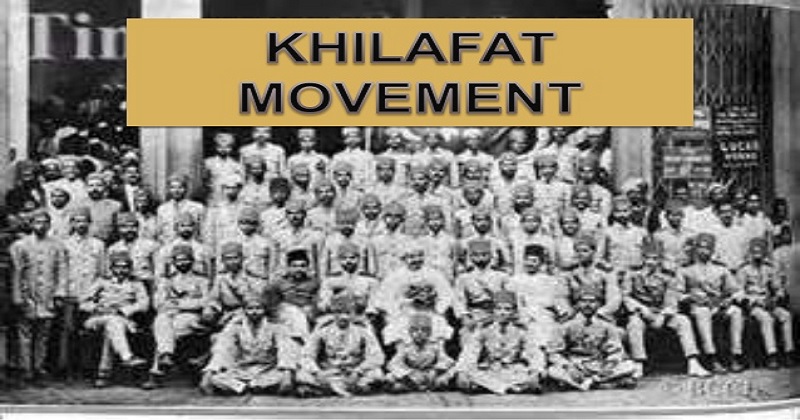
From 1876 to 1909, Abdul Hamid II was the Ottoman emperor. Being a Caliph, the Ottoman emperor was the supreme religious and political leader of all Sunni Muslims across the world. In the World War I, the Ottoman Empire had sided the Central Powers and the result of this war was the defeat of the Central Powers. As per the Treaty a/Versailles (1919), the territorial boundary of the Ottoman Empire got reduced.
Meanwhile, in Turkey, a national movement arose under Mustafa Kemal Ataturk, who was a Pro-western nationalist. He, supported by the western powers, abolished the position of the Caliph. Naturally the Muslims in India became anti-British, as the power and influence of their religious leader was ended.
Khilafat Movement in India
Muslims were especially upset about the future of the Islamic places of worship after the allied powers had partitioned the Turkish Empire. In India Maulana Mohammad Ali Jauhar and his brother Maulana Shaukat Ali along with some other Muslim leaders such as Dr. Mukhtar Ahmed Ansari. Raees-ul-Muhajireen Barrister Jan Muhammad Junejo, Hasrat Mohani, Maulana Abul Kalam Azad and Dr. Hakim Ajmal Khan joined hands a created an All India Khilafat Committee, at Lucknow..
It had two main demands, which were never accepted:
Caliph Sultan must retain sufficient territories so that he is able to defend the Islamic Faith. The places which are called Jazirat-ul-arab, including the Arabia, Syria, Iraq and Palestine must remain under Muslim suzerainty.
The Ali brothers were arrested during the course of the war only to be released from jail after the war was over. This movement reached a crescendo in Bengal, North-West Frontier Province and the Punjab. October 17, 1919 was observed as Khilafat Day. The Hindus also joined hands with the Muslims and a strike was called for. On November 23 1919, the All India Khilafat Conference was organized at New Delhi and later a Khilafat Manifesto was published which called upon the British to protect the Caliphate.
The leaders of the Khilafat Movement joined hands with Indian National Congress for the upcoming Non-cooperation Movement. Again March 19 1920 was observed as Khilafat Day and following that there was an all party conference in June 1920 at Allahabad. The agenda of the Non-cooperation Movement was finalized.
The agenda was:
Boycott of the Titles conferred by the Government
Boycott of civil services, army and police and all other Government offices.
Non-payment of taxes to the government.
The Khilafat movement came and went very quickly. It had lost its relevance when Mustafa Kemal Atatlurk had abolished the Caliphate. The last Caliphate was Abdülmecid II, who was expelled with his family and took asylum in Istanbul (Constantinople), where he spent rest of his life catching butterflies. He died in 1948.
Role of Gandhi in Khilafat Movement
Please note that Gandhi had not called Maulana Muhammad Ali and Shaukat Ali to launch Khilafat Movement. First the leaders met, and then Published their Khilafat manifesto and after only that there was an unwritten pact between INC and Khilafat Movement to work and cooperate on agitation. Gandhi gave them a call to participate in NCM, because he (Gandhi) thought that it was only remedy for British.
Khilafat Movement and Hindu Muslim Unity
The period 1919-22 is understood as the heyday of Hindu-Muslim unity against the colonial rule. This was the period when the leaderships of Congress and the Khilafat movement often overlapped. This was in tune with Gandhi’s idea that British can be fought only with united Hindus and Muslims. Strikes, demonstrations, and Satyagrahas took place around the country, while ‘Hindu-Musalman ki Jai was the famous slogan.
But the above was just ephemeral. After 1922 a series of differences between the Khilafat and Non-Cooperation leaderships intersected with growing popular conflict between Hindu and Muslim communities. Some section of Muslims started to see the futility of Swaraj and fresh interest was awakened in the Muslim League which had been stagnant since 1918.
The most ardent khilafatists started to believe that there was more to be gained by supporting government in its honest efforts than by adhering to the hitherto non-cooperation. Many Muslim leaders raised fears and doubts about the capacity of India to win freedom through civil disobedience. As a result of this, the old dissensions, based upon complaints like cow-slaughter and music before mosque, were raised up and issues of disagreement such as Suddhi Movement or tabligh and sangathan or tanzim were added.
The Hindu Muslim Unity was shattered, giving way to a period of “communalism”. This was the sad demise of the Hindu-Muslim unity as marking a turning point in the freedom struggle. The disintegrated state of affairs then offered an opportunity to the British to re-establish their old relations with the Muslims. They were able to successfully bring the Muslims into their loyalists fold. The so called bond of fraternity turned out to be an ad hoc coalition of interests. India was now on a path to partition.
How Government seeded hate?
The Government created commissions and commissions on one another with an undeclared motive of creating mutual apprehensions and mistrusts. It was the time when the top leaders including Gandhi were failed to understand the political implications of his extensions of support to the cause of Khilafat. Practically, the leaders of Khilafat needed support of Gandhiji only for a defined particular purpose.
Most of the constitutional acts were there to ensure that there was a constant creation of mutual mistrust among the communities. It was made sure that people would understand that the benefit of one caste / community was at the cost of those of others

Post Your Comments